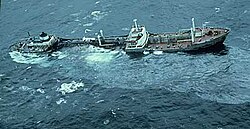Argo Merchant
|
The Argo Merchant after being stranded
|
||||||||||||||||
|
||||||||||||||||
|
||||||||||||||||
|
||||||||||||||||
|
||||||||||||||||
|
||||||||||||||||
The Argo Merchant was a Liberian oil tanker with a measurement of around 18,743 GRT . On December 15, 1976, he was stranded on the Nantucket Shoals and later broke up. About 25,000 tons of oil flowed into the sea.
history
The ship
The ship was built in 1953 as Arcturus with hull number 886 by Howaldtswerke Hamburg . The turbines tanks had to the longitudinal strength of the long time for his body to ensure two longitudinal bulkheads, eleven oil-tight bulkheads and 30 cargo tanks with a total capacity of 38,500 m ³ . The bulwark transitions were made in long straks from the main deck to the superstructures because the client attached importance to harmonious lines.
In 1968 the tanker was renamed Perminia Samudra III , and in 1970 it was renamed Vari . After eleven inconspicuous years of operation, the first problems with the engines, the machinery and the crew began to appear in 1964. From 1964 to 1973 the ship was involved in 14 accidents. These included a collision in Japan, two strandings in Indonesia (as Permina Samudra III ) and Sicily (as Vari ). Then in 1973 the ship was named Argo Merchant by its last shipping company, Thebes Shipping Inc. in Monrovia . From 1975, minor cases of oil spills occurred in Philadelphia and Boston. A commander of the first Coast Guard District recommended that the ship be banned from operating in US waters, which could not be carried out due to the legal situation at the time.
The stranding
In December 1976, the Argo Merchant was under the command of Captain Georgios Papadopoulos on a voyage from Puerto La Cruz in Venezuela to Boston. Their cargo consisted of about 25,000 tons of heavy heating oil No. 6 and about 6000 tons of cutter stock (light petroleum).
On December 15, 1976 around 6:00 a.m., the ship stranded in bad weather with waves over three meters high on the Fishing Rip / Middle Rip Shoal of the Nantucket Shoals , located about 29 nautical miles southeast of the island of Nantucket (position: 41 ° 2 ′ N , 69 ° 27 ′ W ).
In this context, it is worth mentioning the first application of the International Convention on Measures on the High Seas in the Event of Oil Spills , which was passed in 1969 but only came into force in 1975 (Intervention Convention 1969). The US Coast Guard came on board, examined the ship and decided how to proceed, even though the ship was in international waters. Until the Intervention Convention, a port state was only allowed to examine its national waters and only the papers, but not the ship itself. The master of the Argo Merchant asked for permission to pump cargo overboard in order to reduce the draft and allow the ship to float again. After no official permission was given in this regard and all attempts to ease the ship with reserve pumps and an Air Deliverable Antipollution Transfer System (ADAPTS) had failed, the weather situation deteriorated, whereupon the 38-man crew of the distressed vessel was removed.
On December 17th, the ship swung around in the swell and the hull began to bulge. After another four days, on December 21st, the ship broke in two parts, with around 5000 tons of oil flowing into the sea. The forecastle broke off at the fore edge of the bridge superstructure (arranged amidships) and capsized the following day, with the remaining cargo still in it escaping. After the broken forecastle was driven about 400 meters southeast, it was sunk by the US Coast Guard. The stern remained in the stranding position. The Coast Guard made at least two attempts to burn the oil spill in situ , but their project failed.
Due to the local current and tide conditions and north-westerly winds, the oil that leaked further, which had formed an oil slick measuring about 60 by 100 nautical miles, was driven away from the coast of Nantucket. Rescue efforts were made more difficult due to the continued bad weather of the unmapped depths.
examination
The later investigation identified a number of deficiencies that had caused the Argo Merchant to travel 24 nautical miles (44 km) off its planned course. Among other things, the gyrocompass and radio direction finder were defective, two crew members deployed as helmsmen were not sufficiently qualified and there were insufficient sea charts on board.

